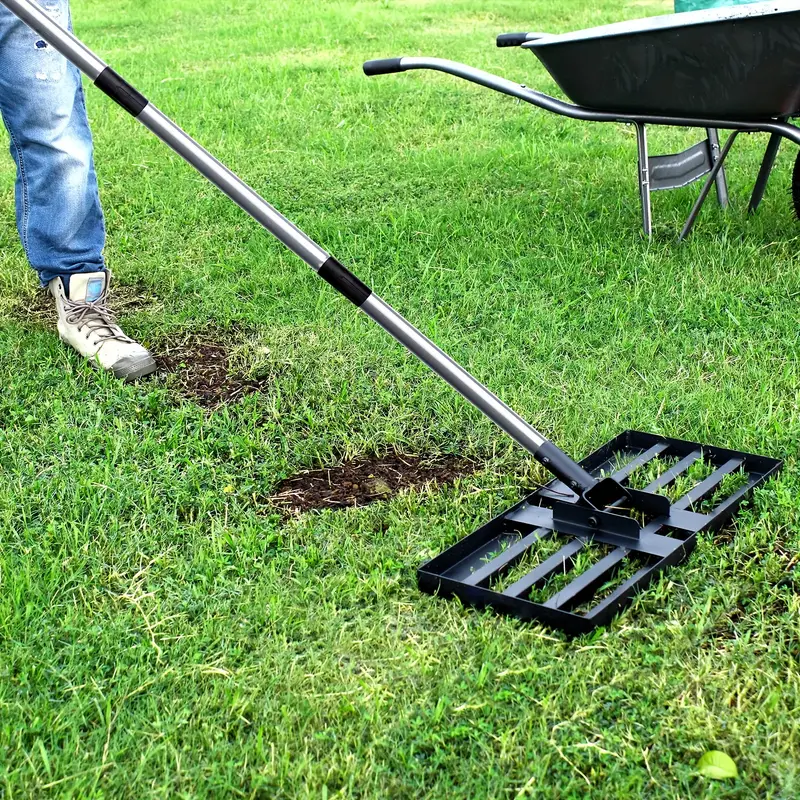What is a Lawn Levelling Rake?
A lawn levelling rake is a specialized tool that has gained popularity among homeowners and landscaping professionals in recent years. Its primary purpose is to smooth out uneven surfaces in lawns and gardens, creating a level and aesthetically pleasing landscape. The unique design of a lawn levelling rake sets it apart from traditional rakes, making it an indispensable tool for anyone serious about lawn care.
The most distinctive feature of a lawn levelling rake is its wide, flat head. This head typically measures between 24 to 36 inches in width, allowing users to cover a large area with each pass. On one side of the head, you’ll find a series of tines or teeth. These tines are designed to break up compacted soil, remove debris, and create a loose surface for levelling.
On the opposite side of the head, a straight edge serves as a levelling blade. This edge is crucial for smoothing out the loosened soil and creating an even surface. The combination of tines and a levelling edge makes the lawn levelling rake a versatile 2-in-1 tool, eliminating the need for multiple implements during the levelling process.
The handle of a lawn levelling rake is usually made from lightweight materials such as aluminum or fiberglass. This design choice ensures that the tool remains manageable even during extended use. Many models feature ergonomic grips or padding to enhance comfort and reduce fatigue during operation.
One of the key advantages of a lawn levelling rake is its ability to work with various materials. Whether you’re spreading topsoil, sand, or a mixture of both, this tool can efficiently distribute and level the material across your lawn. This versatility makes it an excellent choice for a wide range of lawn care tasks, from minor touch-ups to major landscaping projects.

Types of Lawn Levelling Rakes
Several types of lawn levelling rakes are available on the market, each suited for different purposes and lawn sizes. The most common types include:
- Manual lawn levelling rakes
- Tow-behind levelling rakes
- Power rake attachments
Manual rakes are ideal for small to medium-sized lawns and offer precise control over the levelling process. On the other hand, tow-behind rakes are perfect for larger areas and can be attached to lawn tractors or ATVs for efficient coverage. Power rake attachments, meanwhile, are designed for professional use and can handle more extensive landscaping projects with ease.

How to Choose the Right Lawn Levelling Rake
Selecting the appropriate lawn levelling rake depends on various factors. Firstly, consider the size of the area that needs levelling. For smaller lawns, a manual rake will suffice, while larger properties may require a tow-behind model. Secondly, evaluate the rake’s construction materials, opting for durable options like stainless steel or aluminum. Additionally, look for features such as adjustable tines, ergonomic handles, and lightweight designs to ensure comfort and efficiency during use.
Common Mistakes to Avoid When Using a Lawn Levelling Rake
While lawn levelling rakes are relatively straightforward to use, there are some common mistakes to avoid. One of the most frequent errors is applying too much pressure, which can damage the grass or create new depressions. Another mistake is working with wet soil, which can lead to compaction and hinder grass growth. Additionally, failing to properly prepare the lawn or skipping areas can result in an uneven finish. By being aware of these pitfalls and taking care to avoid them, users can ensure a successful levelling project.
After using a lawn levelling rake, proper maintenance is crucial to preserve the newly smooth surface. Water the lawn deeply but infrequently to encourage deep root growth and prevent soil erosion. Avoid heavy foot traffic or placing heavy objects on the lawn for at least a week to allow the soil to settle. Additionally, consider overseeding the levelled areas to promote thick, even grass growth. Regular mowing and fertilization will help maintain the lawn’s appearance and health over time.
Advanced Tips for Professional-Looking Results
For those seeking to achieve a truly professional-looking lawn, there are several advanced techniques to consider. One effective method is to use a mix of sand and topsoil for levelling, which provides excellent drainage and creates an ideal growing medium for grass. Another tip is to use a lawn roller after levelling to further compact and smooth the surface. Furthermore, incorporating soil amendments such as compost or peat moss can improve soil structure and promote healthier grass growth. By implementing these advanced techniques, homeowners can elevate their lawn care game and create a truly stunning outdoor space.

The Benefits of Using a Lawn Levelling Rake
The advantages of incorporating a lawn levelling rake into your lawn care routine are numerous and significant. First and foremost, this tool dramatically reduces the time and effort required to achieve a smooth, even lawn surface. What might have taken hours of backbreaking work with traditional tools can now be accomplished in a fraction of the time, thanks to the efficient design of the lawn levelling rake.
One of the most notable benefits of a level lawn is improved drainage. Uneven surfaces tend to create low spots where water can pool, leading to a host of problems such as root rot, moss growth, and increased susceptibility to pests and diseases. By using a lawn levelling rake to create an even surface, water can flow more freely, preventing these issues and promoting healthier grass growth.
Aesthetically, a level lawn is far more pleasing to the eye than one with bumps, dips, and uneven patches. It creates a polished, professional look that can significantly enhance your home’s curb appeal. Whether you’re preparing your property for sale or simply want to enjoy a beautiful outdoor space, a level lawn makes a noticeable difference.
From a practical standpoint, a level lawn is easier to maintain. Mowing becomes a smoother, more efficient process when you don’t have to navigate around bumps and dips. This not only saves time but also results in a more even cut, further enhancing the lawn’s appearance.
A level surface also contributes to the overall health of your grass. When a lawn is uneven, certain areas may receive more water and nutrients than others, leading to patchy growth. By levelling the surface, you ensure that water and nutrients are distributed evenly across the lawn, promoting uniform growth and a lush, healthy appearance.

Other Lawn Levelling Rakes
The market offers several types of lawn levelling rakes, each designed to meet specific needs and preferences. Understanding the different options available can help you choose the most suitable tool for your lawn care projects.
Manual Lawn Levelling Rakes
These are the most common and versatile type of lawn levelling rakes. Designed for use by a single person, manual rakes are ideal for small to medium-sized lawns. They typically feature a wide head (24-36 inches) with tines on one side and a levelling edge on the other. The handle is usually made of lightweight materials like aluminum or fiberglass for easy maneuverability.
Manual rakes offer precise control over the levelling process, allowing users to apply varying pressure and work around obstacles with ease. They’re particularly useful for spot-treating uneven areas or working in tight spaces where larger equipment can’t reach. While they require more physical effort than mechanized options, manual rakes are cost-effective and suitable for most homeowners.
Tow-Behind Levelling Rakes
For larger properties or commercial applications, tow-behind levelling rakes offer an efficient solution. These rakes are designed to be attached to lawn tractors, ATVs, or other motorized vehicles, allowing users to cover extensive areas quickly and with minimal physical exertion.
Tow-behind rakes typically feature a wider head than manual models, often spanning 4 to 6 feet. This increased width allows for faster coverage of large lawn areas. Many models also include adjustable settings for the rake’s angle and height, providing versatility for different levelling tasks.
While tow-behind rakes are highly efficient for large, open areas, they may not be suitable for smaller lawns or spaces with numerous obstacles. They also require a compatible vehicle for operation, which may not be practical for all users.
Power Rake Attachments
Power rake attachments are specialized tools designed for use with power equipment such as walk-behind tractors or skid steers. These attachments are primarily used by landscaping professionals for large-scale projects or commercial applications.
Power rake attachments typically consist of a rotating drum with multiple tines or blades. As the drum spins, it breaks up compacted soil, removes thatch, and levels the surface simultaneously. Some models also include adjustable depth settings, allowing for precise control over the levelling process.
While power rake attachments are highly efficient and can handle even the most challenging levelling tasks, they require specialized equipment to operate. They’re also more expensive than manual or tow-behind options, making them less practical for typical homeowners.
Combination Levelling Rakes
Some manufacturers offer combination tools that incorporate features of both lawn levelling rakes and traditional landscape rakes. These versatile tools typically have a reversible head with tines on one side and a smooth edge on the other. The tines can be used for breaking up soil and removing debris, while the smooth edge serves as a levelling blade.
Combination rakes are ideal for users who want a multi-purpose tool that can handle various lawn care tasks. They’re particularly useful for those with limited storage space or those who prefer to invest in a single, versatile implement rather than multiple specialized tools.
Adjustable Lawn Levelling Rakes
Some advanced models of lawn levelling rakes feature adjustable heads or tines. These rakes allow users to modify the angle or spacing of the tines to suit different soil types or levelling requirements. The ability to adjust the rake’s configuration makes these tools highly versatile and capable of adapting to various lawn care challenges.
Adjustable rakes are particularly useful for professional landscapers who encounter diverse soil conditions and levelling needs across different properties. However, they can also benefit homeowners who want a tool that can handle a wide range of lawn care tasks.
When choosing between these different types of lawn levelling rakes, consider factors such as the size of your lawn, the frequency of use, your physical capabilities, and your budget. For most homeowners with small to medium-sized lawns, a manual lawn levelling rake or a combination rake will suffice. Those with larger properties or more demanding levelling needs may find tow-behind or power rake attachments more suitable.
Regardless of the type you choose, investing in a quality lawn levelling rake can significantly improve the efficiency and effectiveness of your lawn care routine. By selecting the right tool for your specific needs, you’ll be well-equipped to create and maintain a beautifully level lawn that enhances the overall appearance and health of your outdoor space.







